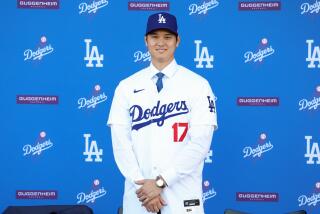Art--and Tax Bills--Are in Eye of the Beholder : Finances: State says producer Ted Field must pay $2.6 million on Italian paintings he brought into California. He claims he is a dealer, not a collector, and therefore is exempt.
- Share via
SACRAMENTO — Even by the standards of the super rich, this was a big art buy. Over a series of years in the 1980s, movie mogul Ted Field invested $19 million in exquisite Italian paintings, which he hung in a sprawling villa he owned in Beverly Hills.
Few outside the world’s elite art circles knew about the deals. But they did not escape the gaze of California’s tax police.
The State Board of Equalization now says Field--whose personal wealth is said to top $600 million--owes $2.6 million in so-called use taxes and penalties for the paintings, which included works by Venetian and Florentine masters.
Field, whose box office hits include “Three Men and a Baby” and “The Hand That Rocks the Cradle,” contends that the tax board has it all wrong. Through his attorneys, the producer argues that he is an art dealer--as opposed to an art collector--and, as such, is exempt from paying the taxes.
The case is one of the biggest of its kind ever decided by the board. Yet because the panel operates in relative obscurity, the matter has received no attention--despite Field’s weighty influence in Hollywood and as one of the nation’s top donors to Democratic candidates and causes.
Last month, the board held a hearing on the dispute in Culver City that Field did not attend. But in a prepared statement for The Times, he said there is an “adequate basis” to support his claim of an exemption, which he said he sought after consulting with a team of advisers.
Field added that he “received a fair hearing” by the board and would comply promptly with whatever decision members make at their meeting next month.
Frederick W. (Ted) Field, 42, is a descendant of Marshall Field, founder of the Chicago-based department store empire of the same name. Known for his keen business acumen, Field nearly tripled his $260-million inheritance during the 1980s through real estate, corporate takeovers and the founding of his successful film company, Interscope Communications.
A private figure, Field is a man of varied passions. He drove race cars until an accident badly mangled his left hand, and he is a promoter of rap music--including some controversial artists--through his explosively successful record label, launched in 1991 and also called Interscope.
Field is also a committed supporter of liberal causes and Democratic candidates, including President Clinton, whom he knows well enough to call Bill. In 1992, Field was the fifth-largest individual donor to the Democratic Party, and he held one of Clinton’s biggest pre-election fund-raisers at his 36,000-square-foot mansion, Greenacres, which he later sold for nearly $18 million.
Art is another fascination of his, one at the center of the spat with California’s tax authorities. Documents show that between 1984 and 1990, Field--assisted by Los Angeles art adviser Larry A. Ross--scoured the globe and acquired a collection of Italian Renaissance and Baroque works, which he displayed throughout Greenacres’ 44 rooms.
The paintings included two early works by Venetian masters--”Sacra Conversazione” by Tintoretto and “Portrait of a Venetian Soldier” by Veronese. Pontormo, Bronzino and Tiepolo were among other artists represented.
The collection was a “cohesive” group of “grand-style pictures” that had a “dignity and nobility about them,” Ian Kennedy, head of the Old Master paintings department for Christie’s London, said before the auction house sold many of the works in 1991. Kennedy described Field’s pictures as reflective of an “old-fashioned taste . . . a J.P. Morgan kind of taste” common in the early 20th Century.
At issue before the board is this key question: Was Field acting as an art dealer when he made his out-of-state painting purchases, buying strictly with the intent to resell? Or was he instead a devotee of Italian art simply decorating his lavish home?
The case involves a little-known levy called the use tax, which was adopted in 1935 as a complement to the sales tax. The use tax was designed to protect California retailers from harm by residents who shop out of state to avoid paying sales taxes.
“If you purchase something out of state and your intention was to use it in California--and you do in fact bring it in for use here--then the use tax applies,” said Dennis Fox, supervisor of audit planning for the board.
Technically, all items bought outside California--even a sweater ordered through a catalogue--are subject to the use tax, which is assessed at the same rate as the sales tax. In reality, authorities only go after big-ticket items, such as planes, vehicles, boats and art. The effort to track down sweater buyers would cost the state more than the payoff in taxes, officials say.
Collecting the use tax is a challenge for the state, in part because authorities rely largely on voluntary compliance, and many people are not aware of the tax. The board’s staff says it tries to publicize the levy through seminars and press releases, and there is a small mention of it in a tax pamphlet.
“Usually, people are quite surprised when we approach them and tell them they owe the tax, because they aren’t aware of it,” Fox said. “Usually, they’re happy to comply.”
To catch the big fish, board staff members often scan newspapers for accounts of private art showings or auctions. That was how they learned that Irvine Co. Chairman Donald Bren had failed to pay levies on $20 million in artwork, and that appears to be how they were alerted to Field’s acquisitions, though officials would not confirm it.
A friend and former employee of Field’s said the producer knew nothing about the use tax until the board approached him with a bill for $2.6 million.
“Ted is involved in many, many, many different businesses,” said the friend, who asked not to be named, “and he relies heavily on his advisers to catch things like this.”
In any case, Field’s response to the bill--made through his attorneys at the April hearing--was that he is exempt because he bought the paintings as a dealer of art, with the strict intent of reselling them. Under the law, the use tax does not apply if an item is bought solely for the purpose of resale in the regular course of the purchaser’s business.
According to a transcript of the hearing, Ross, the art adviser, testified that Field was “100% a dealer” of paintings, as opposed to a collector. From the start of their business relationship, Ross said, Field “made it real clear to me that everything he would buy, he would want to make a profit on and make a profit as soon as possible.”
Field’s friend, who worked for him at the time of the art purchases, echoed that position, saying, “When Ted buys a painting, he’s already trying to figure out how to sell it.”
The board’s investigators sketch a different scene. For starters, they say that Field failed to obtain a Beverly Hills business license or a California seller’s permit--two documents necessary for him to officially engage in the art business. (Records show that Field now has a California seller’s permit, but did not obtain it until February, 1991, a year after the last art purchase at issue in the case.)
If Field was a dealer, board counsel Robert Lambert said at last month’s hearing, he should have filed sales tax returns listing gross receipts for his transactions. He failed to do so, and also took no steps to market himself as a dealer, such as establishing an office, Lambert said.
Finally, Field treated the art as personal assets--rather than dealer inventory--on his federal income tax return, Lambert said. Field’s attorneys acknowledged that fact but said that doing so gave him no financial benefit.
In his statement to The Times, Field said it is “inappropriate, indecorous and self-serving” to comment on the matter prior to a decision by the board. He added that he made his decision to challenge the tax bill “in good faith after consultations with accountants, attorneys and financial consultants.”
More to Read
Inside the business of entertainment
The Wide Shot brings you news, analysis and insights on everything from streaming wars to production — and what it all means for the future.
You may occasionally receive promotional content from the Los Angeles Times.










